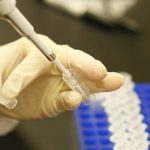The humble mouse, easy and inexpensive to raise in a lab, is one of the most commonly used model organisms and test subjects in medical research.(a) Yet a new study released last week has media outlets raising the alarm about the suitability of mice as stand-ins for humans, with headlines like, “Mice Fall Short as Test Subjects for Humans’ Deadly Ills,” in the New York Times and “This Is Why It’s A Mistake To Cure Mice Instead Of Humans” on Popular Science.1
The truth is a bit more complicated than these headlines might suggest. The study in question, published in The Proceedings of the National Academy of Sciences (PNAS), compares patterns of gene expression in human patients suffering from various types of acute inflammation (burns, endotoxemia, trauma, and sepsis) and the mouse experimental systems designed to model these diseases.(b) Surprisingly, the researchers found that there was very little overlap between the gene expression changes caused by these diseases in humans and in mice. This disparity has troubling implications for drug development, as potential treatments are often identified via testing in mice. The disconnect may explain why nearly 150 drugs that showed promise for treating acute inflammation in mice had little to no effect when it came to humans.
The take-away message of the PNAS paper is that the current mouse models for certain inflammatory conditions do not mimic human disease and are thus unsuitable for identifying and testing potential treatments. These findings will have a profound impact on the study of acute inflammation, particularly for researchers using the mouse models described in the paper. However, despite what some media coverage might suggest, this work does not signal the end for the mouse as a model organism and does not negate the progress that has been made in understanding disease and testing drugs using other mouse models.(c) Furthermore, focusing on the impact that one high-profile failure will have on the field as a whole reflects a lack of understanding of what mouse and other model systems mean to the researchers who use them.
The vast majority of biological science is carried out using different model systems, each of which is designed to answer a specific type of question. For studies involving the most fundamental biological processes, such as DNA replication and metabolism, the simplest single-celled bacteria and yeast have provided some of the most profound insights. Cultures of human cells have shown themselves to be well-suited to biochemical studies, but fall short when it comes to complex organismal processes. Mouse models are excellent for the analysis of complex physiological environments, but suffer from the fact that there are many subtle and not-so-subtle differences between mouse and human biology (as the PNAS paper demonstrates). Although each of these systems can provide valuable insight, as researchers, we know that the models are just that: models. The only perfect model of human disease would be humans themselves, but performing many kinds of research on humans is an ethical and practical impossibility.
As researchers, we are constantly trying to strike a balance between broad understanding and accurate representation. We use cell lines, mice, and other organisms to build conceptual models that allow us to make sense of the vast and complex set of microscopic processes that drive life. In biomedical research, the goal is to apply these conceptual models back to human disease. In some cases this is successful, and the result is promising new treatments and techniques. In other cases, the experimental and conceptual models prove to be off the mark and researchers must go back to the drawing board.
Knowing the limits of our models is just as important as understanding their successes. The PNAS paper, which shows that certain acute inflammation models are incorrect, is undeniably important in that it will redefine the direction of that field of study and lead researchers to search for new tools for examining the problem in humans. Although the study does not invalidate mouse research as an experimental approach, it will serve as a valuable reminder to researchers to be vigilant in ensuring their models are as relevant as possible to human disease. Mouse research will carry on, and it will continue to provide invaluable biological insight and a fertile soil for testing the therapies that many of us will be using ten years down the road.
Endnotes
- Junhee Seok, H. Shaw Warren, Alex G. Cuenca, Michael N. Mindrinos, Henry V. Baker, Weihong Xu, Daniel R. Richards, Grace P. McDonald-Smith, Hong Gao, Laura Hennessy, Celeste C. Finnerty, Cecilia M. López, Shari Honari, Ernest E. Moore, Joseph P. Minei, Joseph Cuschieri, Paul E. Bankey, Jeffrey L. Johnson, Jason Sperry, Avery B. Nathens, Timothy R. Billiar, Michael A. West, Marc G. Jeschke, Matthew B. Klein, Richard L. Gamelli, Nicole S. Gibran, Bernard H. Brownstein, Carol Miller-Graziano, Steve E. Calvano, Philip H. Mason, J. Perren Cobb, Laurence G. Rahme, Stephen F. Lowry, Ronald V. Maier, Lyle L. Moldawer, David N. Herndon, Ronald W. Davis, Wenzhong Xiao, and Ronald G. Tompkins (2013) “Genomic responses in mouse models poorly mimic human inflammatory diseases,” Proceedings of the National Academy of Sciences of the United States of America, published ahead of print on February 11.
Sidenotes
- (a) Other organisms commonly used to model biological processes and systems include yeast, worms, flies, and primates.
- (b) The researchers looked at gene expression by profiling the relative amounts of each RNA molecule. RNA is a cousin of DNA that is involved in a number of cell activities, including the processes by which the genes from DNA are expressed (that is, put into action). Looking at RNA is thus helpful for identifying biological processes that are occurring within cells.
- (c) Virtually every drug goes through pre-clinical testing in mice before it reaches clinical trials in humans. The cancer drug Gleevec, for example, was curing mice long before it restored normal life expectancy to patients with certain types of leukemia.





